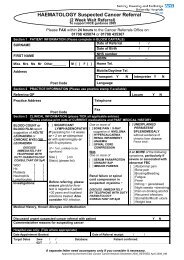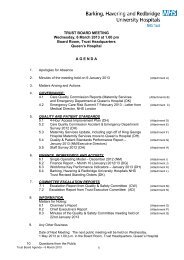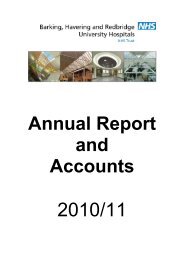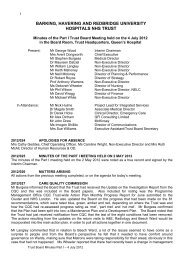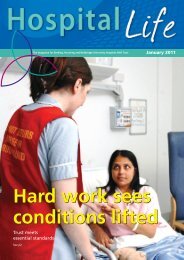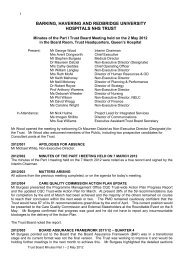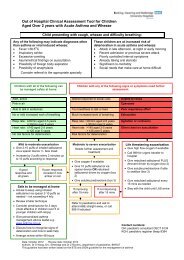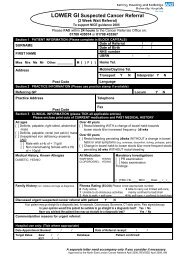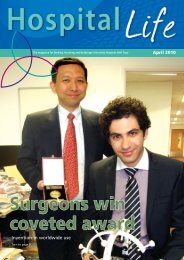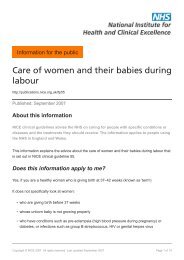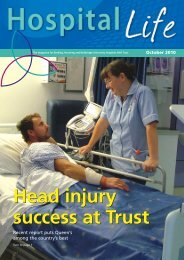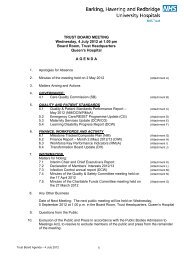Vaginal Birth after Previous Caesarean (VBAC) - Barking, Havering ...
Vaginal Birth after Previous Caesarean (VBAC) - Barking, Havering ...
Vaginal Birth after Previous Caesarean (VBAC) - Barking, Havering ...
- No tags were found...
You also want an ePaper? Increase the reach of your titles
YUMPU automatically turns print PDFs into web optimized ePapers that Google loves.
<strong>Vaginal</strong> <strong>Birth</strong> <strong>after</strong> <strong>Previous</strong><strong>Caesarean</strong> (<strong>VBAC</strong>)Information for youIssued: September 2012Review: September 2015Many women who have had a caesarean section before could give birthvaginally next time. At <strong>Barking</strong> <strong>Havering</strong> and Redbridge University HospitalsNHS Trust (BHRUT) we aim to support you with having a vaginal birth.However there are a number of issues for you to consider and the informationbelow may help answer any questions you have. Please discuss any of thesubjects raised in this leaflet with your midwife, consultant obstetrician orconsultant midwife (public health).If you have had one previous caesarean section and have no other medical orpregnancy related problems, you will be referred to see the midwife in thebirth options clinic. The midwife will discuss <strong>VBAC</strong> vs Elective Repeat<strong>Caesarean</strong> Section (ERCS) and document a plan of care for the birth. If youdo have a medical or pregnancy related problem you will be referred to seethe consultant obstetrician.1. <strong>Vaginal</strong> <strong>Birth</strong> <strong>after</strong> <strong>Caesarean</strong> Section (<strong>VBAC</strong>)When midwives and doctors talk about a vaginal birth <strong>after</strong> a caesareansection, they often refer to it is as ‘<strong>VBAC</strong>’ – pronounced “vee back”. Labour<strong>after</strong> a previous caesarean section is often called “trial of labour” or “trial ofscar”.Why did you have a caesarean section last time? Will you need to haveanother one?It can be helpful to talk with a midwife or doctor about why you had yourprevious caesarean section. Most reasons for having a caesarean section areunlikely to recur. Occasionally you might need a caesarean for a differentreason altogether. If this is your second baby then your chances of havinganother caesarean are roughly the same as they were the first time you werepregnant.
What are the advantages of <strong>VBAC</strong>?• Most women who choose a <strong>VBAC</strong> do succeed in having a vaginal birth.For women who have had one previous caesarean section the chancesof successful planned <strong>VBAC</strong> are 72-76%• Your recovery will be quicker if you have a vaginal birth and you will beable to go home from hospital much sooner <strong>after</strong> the birth.• A caesarean is a major operation and you will need time to recover (acaesarean section will mean that you have an abdominal wound whichcauses increased pain and limits your mobility). A shorter and easierrecovery means that you will also be better able to care for your otherchild or children following a vaginal birth.• If you succeed once in having a <strong>VBAC</strong> you are more likely to have avaginal birth for any future babies.• <strong>VBAC</strong> probably reduces the risk that your baby will have breathingproblems <strong>after</strong> birth: rates are 2–3 in 100 with planned <strong>VBAC</strong> and 3–4in 100 with elective repeat caesarean.• If you have a vaginal birth you are more likely to breastfeedsuccessfully and the ‘attachment’ with your baby is reported by womento be easier.• There is also more risk of complications during a caesarean such asinfections, blood clots (thrombosis) or blood transfusion due to very lowiron levels (anaemia).Will it make a difference if I’ve had any babies vaginally before?• If you have had any vaginal births before, either before or <strong>after</strong> yourcaesarean, then this makes it even more likely that you could give birthvaginally this time.What are the risks of <strong>VBAC</strong>?• When a woman has had a caesarean section her uterus has a scar onit. This scar may not be as tough as the surrounding muscle, so thestretching of the muscle during pregnancy or the strong contractions oflabour could cause it to become thin or begin to separate. In practice, itis rare that this happens. When it does, it is known as “scardehiscence” and surprisingly, it doesn’t usually cause any problems –providing there is no bleeding.• A woman who has had a previous caesarean is at more risk of auterine rupture. This is when the old scar does not stand the strain oflabour and splits open. Uterine rupture is life threatening for bothmother and baby. With modern caesarean scars, the risk of thishappening is about 1 in 200 (0.5%). If you have already had one ormore 'normal' births since your caesarean section, then your risk ofuterine rupture is decreased. If a uterine rupture happens duringlabour, the woman needs to have a caesarean section as soon aspossible.
• However, whatever kind of delivery you have - if you have had acaesarean section, your risk of having a uterine rupture in laterpregnancies or labours is increased.• Overall there is a very small increased risk of needing a bloodtransfusion, or having an infection in the womb if you have an attemptat <strong>VBAC</strong>.• Risks of damage to the baby during labour are very similar to the risksfor a woman having her first baby. Damage to the baby during labour isvery rare and happens to less than 1 in a 1000.What happens in a <strong>VBAC</strong>?As you have had a previous caesarean section, it will be recommended thatyou have your baby in hospital. Once you are in ‘active’ labour you will beadvised to have your baby’s heartbeat monitored continuously. You may wishto discuss this more with your midwife or obstetrician. You can still sit androck on the birth ball, or sit in an armchair and find comfortable, uprightpositions to help you work with your contractions.We will also ask for your permission to take blood specimens so that we areable to cross-match blood quickly if problems arise.Is there anything I can do to increase my chances of a vaginal birth?Good support in labour is one of the most important factors in helping womenhave a normal birth. Having lots of encouragement to get through labour andfeeling well cared for is known to help women cope with the pain of labour. Itmay also affect the length of labour and what sort of birth you have (althoughthere are other factors that influence your labour too). You may find it helpfulto have another birth supporter, as well as your partner, with you.Being able to move freely and adopt different positions is also likely to helpkeep your labour normal. Women often find movement a helpful way of copingwith pain and being upright will help get your baby’s head into a good positionand encourage it to descend into your pelvis.We offer antenatal classes for women who have had a previous caesareansection and are unsure of how they wish to give birth this time or wish to tryfor a <strong>VBAC</strong>. The classes also give you a chance to meet other women havinga similar experience. Please ask your midwife for details.2. Elective Repeat <strong>Caesarean</strong> Section (ERCS)When is an ERCS recommended?If you have had a first caesarean because of a recurring problem, you willprobably be advised to have a caesarean birth this time too. Examplesinclude major maternal heart or lung disease, unusual pelvic shape or size,and any vertical incision (up and down cut) on the uterus (womb).
What are the risks of an ERCS?It is extremely rare for a woman to die as a result of childbirth today butwomen who have a caesarean birth are still at slightly greater risk. The risksand complications will also be increased with other lifestyle or medical factorssuch as:• Smoking• <strong>Previous</strong> abdominal surgery - which may have also caused internal“adhesions” (bands of scar-like tissue that form between two surfacesinside the body)• The number of previous caesarean sections• A caesarean birth is a major operation and you will stay in hospitallonger and have a longer recovery time compared to a <strong>VBAC</strong>• Lifting heavy loads and driving may be restricted until you are fullyrecovered• The risks for the baby are a greater chance of breathing difficulties (3-4in 100) and a small risk of a scratch or small cut to the baby’s skin (thishappens to approximately 2 in 100 babies born by caesarean section).In future pregnancies there are also greater risks of:• Placenta praevia (the <strong>after</strong>birth implants over the cervix making avaginal birth either very dangerous or impossible)• Placenta accreta (the <strong>after</strong>birth is so firmly attached to the wall of theuterus that it fails to separate <strong>after</strong> the birth of the baby, causing agreater risk of serious bleeding for the mother)• Severe adhesions between bladder and bowel making a furthercaesarean section more difficult and increasing the risks ofcomplications.• The more caesarean sections that you have had the greater thechances of needing a hysterectomy at the time of the next caesareansection.What are the advantages of having an elective repeat caesareansection?• You may find that your experience is less upsetting than your previouscaesarean birth if your previous caesarean was unplanned.• You have a planned procedure rather than an emergency/unplannedoperation during labour.• There is virtually no risk of uterine rupture in ERCS.What if you have had more than one previous caesarean section?If you have had two or more previous caesarean sections there might be avery small increase in the risk of scar rupture, however, the overall riskremains small. If you are unsure of how you wish to give birth this time or wishto have a <strong>VBAC</strong> you will be referred to see the consultant midwife (publichealth) to discuss your birth plan. You will then see the obstetrician later in
your pregnancy at about 36 weeks. If you wish to have an ERCS you will bereferred to see the obstetrician.What if you have twins?The safety of a twin delivery <strong>after</strong> a previous caesarean section is unknown.You should discuss the options with your consultant obstetrician.What if your baby is preterm (born between 24-36 weeks)?If your baby is preterm (24-36 weeks) a planned preterm <strong>VBAC</strong> has similarsuccess rates to planned term <strong>VBAC</strong> but with a lower risk of uterine rupture.There is a higher success rate with a preterm <strong>VBAC</strong> (82%) compared to aterm (37-42 weeks) <strong>VBAC</strong> (72-76%)What if your pregnancy is overdue and you are considering a <strong>VBAC</strong>?You should be offered a ‘membrane sweep’ <strong>after</strong> 40 weeks of pregnancy asthis can result in spontaneous labour in 24-48 hours in about 50% of cases.The risks of scar rupture are greatly increased by induction of labour,especially if you need to have a prostaglandin tablet (this helps to soften andshorten the cervix (neck of the womb) and start labour. The tablet is insertedinto the vagina. An appointment will be made so that the consultantobstetrician can discuss the pros and cons of induction with you.There is a two- to three-fold increased risk of uterine rupture and around 1.5-fold increased risk of caesarean section in induced and/or augmented(speeded up) labours compared with women whose labour starts naturally.
References:National Institute for Health & Clinical Excellence (2011). <strong>Caesarean</strong> Section.London: NICE.National Institute for Health & Clinical Excellence (2004). <strong>Caesarean</strong> Section.London: NICE.NHS Institute for Innovation and Improvement (2007). Focus on normal birth andreducing <strong>Caesarean</strong> section rates. Coventry: NHS Institute for Innovation andImprovement. Available at: www.institute.nhs.ukRoyal College of Obstetricians and Gynaecologists (2007). <strong>Birth</strong> <strong>after</strong> <strong>Previous</strong><strong>Caesarean</strong> Section. London: RCOG. Available at: www.rcog.org.ukNational Institute for Health & Clinical Excellence (NICE) (2007). Intrapartum care:care of healthy women and their babies during childbirth. London: NICE.For more information:Discuss with your obstetrician or midwife or request to see the consultantmidwife (public health).Useful Websites/telephone numberswww.nice.org.ukwww.caesarean.org.ukwww.vbac.org.uk<strong>VBAC</strong> information line 01256 704 871www.homebirth.org.uk/vbac.htmwww.<strong>Birth</strong>ChoiceUK.comwww.aims.org.ukAssociation for improvements in maternity services (AIMS) 0870 765 1433PALSFor a translated, large print or audio tape version of this document pleasecontact the Patient Advice and Liaison Service (PALS) on 0800 389 8324.Compiled by Claire Homeyard, Consultant Midwife (Public Health).



![[4] Biopsy Leaflet.pub - Barking, Havering and Redbridge University ...](https://img.yumpu.com/51285530/1/190x134/4-biopsy-leafletpub-barking-havering-and-redbridge-university-.jpg?quality=85)

